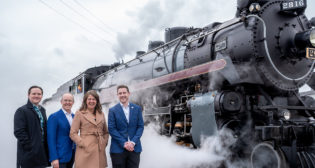
Watch: Parallel Systems Tests Railcar ‘Platooning’ in California
Written by Marybeth Luczak, Executive Editor![According to Parallel Systems, its autonomous battery-electric freight cars “form platoons through bumper-to-bumper contact.” Traditional coupling is not required, allowing “freight to [be] sort[ed] on the rail network,” it reports. (Parallel Systems Photograph)](https://www.railwayage.com/wp-content/uploads/2024/02/Screen-Shot-2023-12-20-at-3.22.51-PM.png)
According to Parallel Systems, its autonomous battery-electric freight cars “form platoons through bumper-to-bumper contact.” Traditional coupling is not required, allowing “freight to [be] sort[ed] on the rail network,” it reports. (Parallel Systems Photograph)
Los Angeles, Calif.-based Parallel Systems on Dec. 20 released a video of its new autonomous battery-electric freight cars, which it said showed them “successfully platooning,” or “connecting with one another through bumper-to-bumper contact,” at its Southern California test track.
The individually powered railcars are designed to transport standard shipping containers as a single or double-stacked load in short-haul freight operations, and can form “platoons” of up to 50 cars, according to Parallel Systems. “The fully automated platooning process eliminates the requirement for railcars to couple to each other and connect air brake lines,” the company explained (see video below). “Upon contact, each vehicle maintains bumper contact with the one in front by controlling tractive effort. The small air gap between containers and the pushing action through railcar bumpers reduces average aerodynamic drag of the platoon, ultimately improving energy efficiency. Individual railcars can also separate from one another, enabling them to bypass rail classification yards and independently proceed to varied destinations, or to keep railroad crossings clear. Brake systems are self-contained in each railcar and therefore do not require connecting air lines.”
According to Parallel Systems, platooning technology allows railroads “to sort freight anywhere along the network where there is a switch.”
The company debuted its second-generation car in September. Platoon testing began in October, and “performance has been consistent with our modeling and simulations, which is exciting right out of the gate,” Parallel Systems Co-founder and CEO Matt Soule said in a Dec. 20 statement. “The vehicles have remained connected according to plan, allowing us to plan expanded platoon testing with increased speeds, greater number of vehicles and braking. Introducing platooning will help the rail industry address a range of critical challenges, including sorting and routing freight more quickly and keeping railroad crossings open for roadway and pedestrian traffic.”
Earlier this month, Parallel Systems and Arc Infrastructure of Australia unveiled the prototype of their new Hiivr Rail system, comprising autonomous battery-powered railcars to move containers within ports and terminals. The new system was developed for the future Westport container port in Perth, with the goal of replacing fossil fuel-powered trucks and loaders, while offering automatic integration with logistics systems and real-time visibility of container movements, according to a report by International Railway Journal, a Railway Age sister publication. Hiivr Rail cars can also be coupled together to form an autonomous freight train, the report said. The new system will be tested on main lines in Australia, with the aim of integrating it with Arc Infrastructure train control systems.
In the United States, Genesee & Wyoming Inc. (G&W) subsidiaries Georgia Central Railway, L.P. (GC) and Heart of Georgia Railroad, Inc. (HOG) on Aug. 10 filed a petition with the Federal Railroad Administration (FRA) to pilot Parallel Systems railcars on portions of their rail lines. If approved, the railroads said a multi-phased pilot would begin in 2024 and be overseen by the FRA, G&W and Parallel Systems, allowing G&W and Parallel Systems to “demonstrate the technology in a field setting while using carefully developed protocols to ensure the pilot is operated in a safe, controlled manner.”
Parallel Systems, founded by three former SpaceX engineers, was awarded a $4.4 million U.S. Department of Energy grant in February 2022 to test its railcar technology. The award followed the company’s January 2022 report stating that it had raised $49.55 million in Series A funds to help build a fleet of new railcars for short-haul freight operations, continue testing and grow the company.



